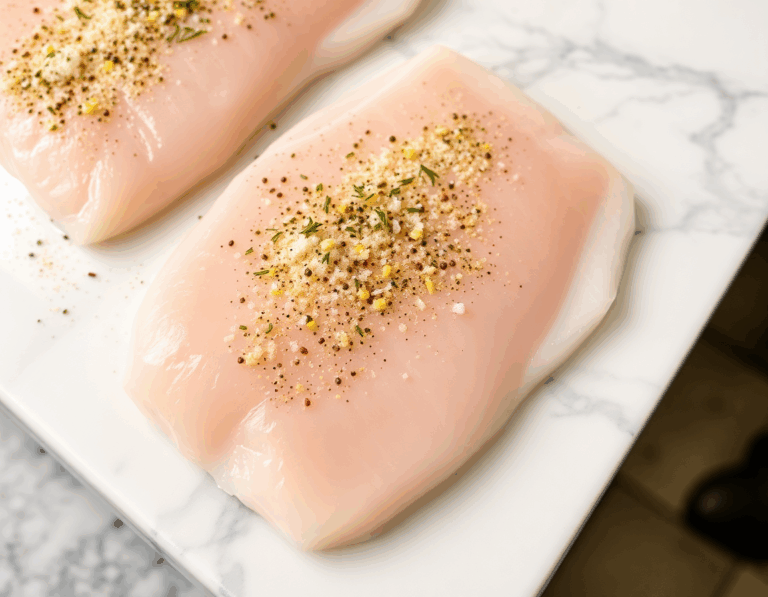Ah, baked steelhead trout—it’s the culinary equivalent of a warm hug on a rainy day. Imagine the golden, crispy edges, kissed by lemon’s bright tang and an aromatic herb symphony. I first made this dish during a chaotic week, and somehow, it brought peace to the storm—like a Taylor Swift song.
Steps
- Begin by selecting fresh steelhead fillets, ensuring they are cleaned and scaled. Pat the fillets dry with paper towels to remove excess moisture.
- Preheat your oven to 400°F (200°C) while you prepare the fillets. Line a baking sheet with parchment paper or lightly oil it to prevent sticking.
- Season the steelhead fillets on both sides with salt, pepper, and any other preferred spices or herbs. Common choices include dill, garlic powder, and lemon zest for added flavor.
- Arrange the seasoned fillets skin-side down on the prepared baking sheet. If desired, add lemon slices or fresh herbs on top of the fish for enhanced aroma and taste.
- Place the baking sheet in the preheated oven and bake the steelhead for approximately 12-15 minutes, or until the fish flakes easily with a fork. The internal temperature should reach 145°F (63°C) for safe consumption.
- Once cooked, remove the fillets from the oven and let them rest for a couple of minutes. Serve the steelhead with your choice of sides, such as roasted vegetables or a fresh salad.

Ingredients
FAQ
- What distinguishes steelhead trout from rainbow trout?
- Steelhead trout are the sea-run form of the rainbow trout, meaning they migrate to the ocean and return to freshwater to spawn. In contrast, rainbow trout remain in freshwater their entire lives. Steelhead tend to be larger and less colorful than rainbow trout, and they can grow up to 55 pounds and 45 inches in length.
- How does the steelhead trout’s appearance change between freshwater and saltwater environments?
- In the ocean, steelhead trout have a silvery color, which helps them blend into their surroundings. When they return to freshwater to spawn, their coloration becomes more similar to a typical rainbow trout, with darker green hues and a pink horizontal stripe.
- Why are some steelhead trout populations considered endangered or threatened?
- Several steelhead populations are at risk due to factors such as changing ocean conditions, overfishing, habitat destruction, and barriers like dams that block migration routes. Human activities have significantly impacted their numbers, especially in areas like Southern California.
- What is the significance of steelhead trout’s homing behavior?
- Steelhead trout exhibit a remarkable ability to return to their natal streams to spawn, even after spending years in the ocean. They use chemical cues to navigate back to their birthplace, which results in genetically distinct subpopulations within different streams or regions.
- What conservation efforts are in place for steelhead trout?
- Various conservation programs have been initiated to help recover steelhead populations, particularly in regions where they are endangered. These programs focus on habitat restoration, improving fish passage, and enhancing water quality, with significant investments made to support their recovery.
Tips
- Choose Fresh Steelhead: When purchasing steelhead, make sure it has a fresh, mild smell and firm flesh. This ensures the best flavor and texture for your dish.
- Handle with Care: Steelhead has delicate flesh, so handle it gently to prevent it from breaking apart. Use a non-stick pan or parchment paper to keep it from sticking during cooking.
- Season Simply: Steelhead has a naturally rich flavor, so a simple seasoning of salt, pepper, and lemon juice can enhance its taste without overpowering it.
- Watch the Cook Time: Steelhead cooks quickly, so keep an eye on it to avoid overcooking. Aim for a slightly translucent center and a firm texture for optimal results.
Equipment
- Fish Fillet Knife: A specialized knife for filleting fish, which is essential for cleaning and preparing steelhead trout.
- Fish Scaler: If you’re working with whole fish, a fish scaler can help remove scales efficiently.
- Grill or Smoking Equipment: A portable grill or smoker can be useful for preparing steelhead trout with a smoky flavor.
- Cast Iron Skillet or Non-stick Pan: Useful for searing or pan-frying the fish.
- Fish Poacher: If you plan to poach the fish, a fish poacher may be necessary.
- Meat Thermometer: To ensure the fish is cooked to the correct temperature.
- Fish Turner/Spatula: A slotted spatula designed for turning fish without breaking it.
- Cedar Planks: For grilling or baking to add a unique flavor to the fish.
